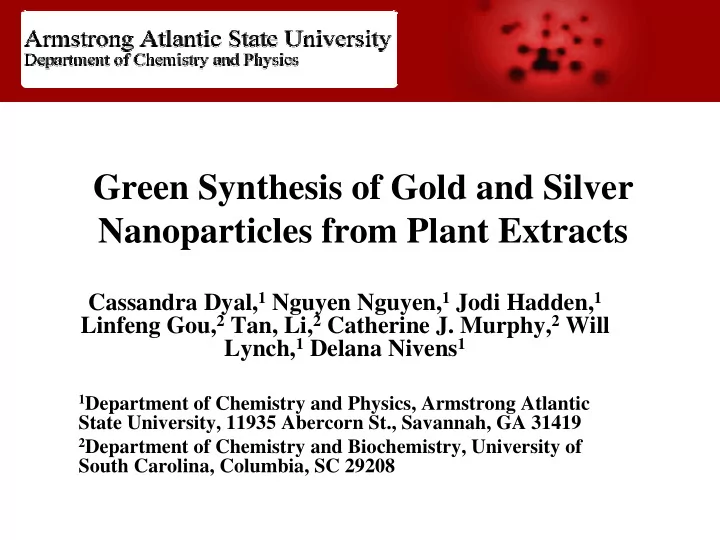

Green Synthesis of Gold and Silver Nanoparticles from Plant Extracts Cassandra Dyal, 1 Nguyen Nguyen, 1 Jodi Hadden, 1 Linfeng Gou, 2 Tan, Li, 2 Catherine J. Murphy, 2 Will Lynch, 1 Delana Nivens 1 1 Department of Chemistry and Physics, Armstrong Atlantic State University, 11935 Abercorn St., Savannah, GA 31419 2 Department of Chemistry and Biochemistry, University of South Carolina, Columbia, SC 29208
Abstract The synthesis of metal and semiconductor nanoparticles is an expanding research area due to the potential applications for the development of novel technologies. Generally, nanoparticles are prepared by a variety of chemical methods which are not environmentally friendly. We report a rapid and convenient method to reductively prepare gold and silver nanoparticles from auric chloride and silver nitrate respectively. In this report we use aqueous extracts from plants indigenous to southeastern Georgia, namely the Southern Live Oak ( Quercus virginiana ), Southern Magnolia ( Magnolia grandiflora ), Kudzu ( Pueraria lobata ) and Loblolly Pine ( Pinus taeda ). The extracts template the reductive preparation of both gold and silver nanoparticles which are found to be < 100 nm in size. The synthesis and characterization, including FT-IR, TGA and TEM analysis of these particles will be described.
Purpose Identify “green” pathways to produce nanoparticles using regionally (south Georgia) significant resources Presently, minimal information on using environmentally benign chemicals for particle synthesis
Experimental Prepare aqueous extract – broth prepared by boiling 20 grams of plant leaf mass in 100 mL distilled water for 5 minutes followed by filtering. Broth stored in refrigerator at 4ºC. Use extracts from: Quercus virginiana – Southern Live Oak Magnolia grandiflora – Southern Magnolia Gold Nanoparticles Pueraria lobata – Kudzu Pinus taeda – Loblolly Pine Add 5 mLs of extract with 100 mLs of 1 mM AgNO 3 or AuCl 3 heated to 75ºC. Maintain this temperature for the entire reaction (different plant extracts require different times to complete the reaction) Monitor the UV-Vis spectrum of the particle formation (exciton band near 430 nm for silver and 550 nm for gold Centrifuge product, wash 3 x with di water and perform FT-IR, TGA and TEM analysis
Ag Nanoparticle Formation Live Oak Magnolia UV-Vis Spectra of the Formation of Silver Nanoparticles Using Live Oak Leaf Broth 2.5 2 Absorbance 1.5 1 0.5 0 200 300 400 500 600 Wavelength (nm)
Au Nanoparticle Formation Live Oak Magnolia 1.5 Absorbance 1 0.5 0 300 400 500 600 700 Wavelength (nm)
Pine (Cold) Ag/Au Nanoparticle Formation – Other Plants Pine (Hot) Kudzu
Au Nanoparticle Formation – Temperature Dependence Gold Nanoparticles Formation Rate 2.00000 1.50000 Absorbanc 1.00000 (Au) 0.50000 0.00000 0 4 8 12 16 20 -0.50000 Time (min) 40 60 23 80 70
Au Nanoparticle Formation – Concentration Dependence Gold Nanoparticles Formation Rate 0.50 Absorbanc (AU) 0.00 0 4 8 12 16 20 Time (min) Room Temp. Room Temp. 2x Extract
“Green” Nanoparticle IR Analysis Ag – Live Oak 80 1355 3186 79 -1 ) Functional group Biomolecule Wavenumber (cm 1044 Alkane, C-O stretch Lipids % T 1613 Amide Amino acids 78 2917 Alkane C-H stretch Lipids 1613 3186 Hydroxyl group Sugars 3351 N-H amines Amino acids 77 2917 3351 1044 76 3400 2400 1400 400 Wavenumber (cm -1 )
“Green” Nanoparticle IR Analysis Au – Magnolia 55 -1 ) W a v e n u m b e r (cm F u n ctio n a l g ro u p B io m o le cu le 45 1 1 4 1 C -O ,C -N o r C C S tre tc h L ip id s, A m in o a cid s ,S u g a rs 2931 cm -1 1 4 5 0 C H , O H b e n d L ip id s, S u g a rs 35 1 6 2 7 A m id e A m in o a cid s 1141 cm -1 2 9 3 1 A lka n e C -H stre tch L ip id s 3 5 2 0 N -H a m in e s A m in o a cid s 25 3502cm -1 1627cm -1 1450 cm -1 15 4000 3500 3000 2500 2000 1500 1000 500
TGA Analysis 100 Gold - Magnolia 80 Weight % 60 Scan Rate = 20 °C/min 40 100 250 400 550 700 850 1000 Live oak loss-28% Temperature ( o C) 100 Magnolia Loss 57% 90 Weight % 80 Gold Live Oak 70 100 250 400 550 700 850 1000 Temperature ( o C)
TGA Analysis 100 Silver, Magnolia 85 Weight % Loss of 44% 70 Scan Rate = 40 °C/min 55 100 250 400 550 700 850 1000 Temperature ( o C)
Conclusions 1. Green methods for NP preparation are being developed 2. Pine and Live oak extracts seem to be the fastest for the preparation of both gold and silver nanoparticles while Kudzu is the slowest. 3. Rate of reaction is dependent upon T and [ M n+ ] 4. IR indicates biomolecule capping agent present 5. Sizes are typically on the order of 20 nm by TEM imaging. 6. Some interesting triangle shaped nanoparticles are seen in the gold nanoparticles
Acknowledgements •National Science Foundation Division of Undergraduate Education: Nanotechnology in Undergraduate Education Grant CHE/NUE 0303994 •National Science Foundation Course Curriculum and Improvement Grant DUE/CCLI - 9952343 •USG Matching Grant •AASU College of Arts and Sciences, Department of Chemistry and Physics •AASU Research and Scholarship Grant / Gignilliat Scholarship
Recommend
More recommend